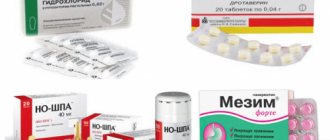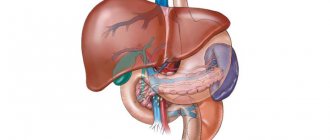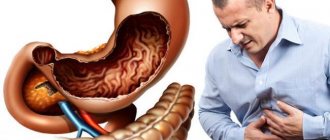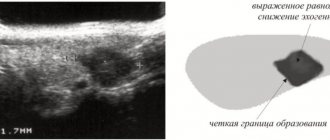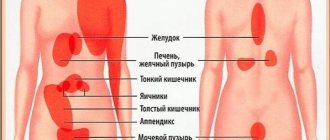Pain to the right of the navel indicates the presence of a serious disease in the body. Read more in this article.
Many people who experience belly button pain are completely unaware of how harmful it can be later on. Often this cannot be triggered solely by stress or a busy day. The problem may lie much deeper. The fact is that to the right of the navel are vital organs. When their disease occurs, the pain first spreads to the navel area.
Read in another article on our website why it hurts to the left of the navel . It describes a lot of useful information - what such pain means, how to get rid of it and which doctor to see.
This article below contains information about pain to the right of the navel. What to do if it hurts? What are the reasons for this pain? Find answers to these and other questions further.
What organs are located in the navel area on the right: diagram
Diagram of the location of organs in the navel area on the right.
Each pain signal can indicate a malfunction of internal organs or their partial dysfunction. For example, in the area to the right of the navel in a person the following important organs are located:
- Big seal
- Upper ureters and kidneys
- Small intestine and colon
- Gallbladder
- Pancreas
- Gate of the right kidney
- Diaphragm part
- Curvature of the stomach
Here is a diagram of the location of the internal organs of this area:
Diagram of the location of organs in the navel area on the right
Other reasons
A discomfort in the right region occurs with pathologies of the following parts of the body:
- kidneys, adrenal glands;
- gallbladder, pancreas.
For example, if a patient develops cholecystitis, the walls of the gallbladder become inflamed. There are a large number of nerve endings that send signals to the brain. As a result, the patient experiences pain on the right side, since the organs are located in this area.
Additionally, there are other diseases that cause similar symptoms:
- peptic ulcer of the stomach and duodenum, gastritis;
- formation of stones in the gallbladder;
- hepatitis, hepatosis, fatty liver degeneration;
- diaphragm dysfunction.
Pain to the right of the navel occurs during the formation of a malignant tumor. It spreads to the walls of the small intestine, causing aching, nagging pain. It develops constantly, with periods of remission. The condition intensifies if you press your fingers on the navel area. If there is a suspicion of a tumor, it is recommended to consult simultaneously with a surgeon and an oncologist.
Abdominal pain to the right of the navel in women and men: causes, what to do?
In women and men, when abdominal pain occurs to the right of the navel, the following diseases are often diagnosed:
- Umbilical hernia
- Pancreatic damage
- Stomach ulcer
- Diverticulitis
- Appendicitis
- Kidney pathology
Umbilical hernias in an adult are divided into oblique and direct:
- An indirect umbilical hernia usually occurs under the umbilical ring. The protrusion passes through the gap, namely between the umbilical canal and the white line of the abdomen. After which the hernia extends into the subcutaneous fat.
- A direct umbilical hernia is formed as a result of thinning of the transverse fascia, which is directly connected to the umbilical ring. Here the hernia protrudes into the subcutaneous tissue. Severe pain to the right of the navel, nausea, and vomiting are symptoms that appear when an umbilical hernia is strangulated.
Abdominal pain to the right of the navel in women and men
Damage to the pancreas:
- It begins with the initial stage - pancreatitis.
- If this disease is not cured in time, it can become complicated.
- Damage to the pancreas is usually accompanied by pancreatic colic, which occurs to the right of the umbilical ring.
- You can also experience aching pain in the back and upper torso. Even analgesics cannot save you from such pain.
Stomach ulcer:
- Often occurs as a result of poor nutrition.
- The first sign of this diagnosis is a sharp pain to the right of the navel in the upper part.
- Painful sensations are accompanied by vomiting, dizziness, and sudden changes in appetite.
- If the condition is severe, blood clots can be observed in the vomit.
Diverticulitis:
- This is a pathological disease that affects the rectum, causing suppuration of diverticula, as well as acute pain to the right of the umbilical region.
- Diverticula are formed as a result of poor nutrition and metabolic disturbances.
- They are a depression in the mucous membrane, which is very similar to a hernia.
Appendicitis:
- A common disease.
- With sharp, inexplicable pain in the right side of the abdomen, all suspicions fall on him.
Cold sweat, decreased blood pressure, and vomiting are the main symptoms of acute appendicitis. At the first ailment and pain in the navel area, consult a doctor immediately.
Causes of pain in women
In women, the reproductive system organs are located in the lower abdomen. Pathologies in this area cause pain radiating to the navel area.
- Endometriosis
. This is a chronic disease in which connective tissue grows on the wall of the uterus. If the pathology is not eliminated or neglected in a timely manner, the growths will be abundant, which will provoke a malignant neoplasm. The main cause of the condition is hormonal changes, which can be either physiological or pathological. For example, it often forms in patients of adolescence due to the development of puberty. - Endometrial hyperplasia
. This is a hormonal pathology in which the uterine tissue thickens in size. The symptoms are vague, making diagnosis difficult.
If the patient has uterine pathology, the following symptoms form:
- increasing the period of discharge during menstruation to 10 days;
- spread of pain from the lower abdomen to the navel area;
- low-grade fever, which sometimes reaches up to 38 degrees;
- anemia with periodic appearance of pale skin, decreased blood pressure, weakness, and deterioration in performance.
If a woman develops uterine bleeding that does not stop on its own, contact a gynecologist. It can only be eliminated by scraping. During the procedure, additional diagnostics are performed. This can be done using a curette and a vacuum device. The obtained biological material is sent for histological examination and other diagnostic methods.
Additionally, the following pathologies are identified, which are often found in women and are accompanied by pain extending to the navel:
- benign neoplasms on the uterus;
- inflammation of the bladder, ovaries, appendages;
- cervical erosion;
- bacterial infection of the kidneys, glomerulonephritis.
After identifying the disease, the patient is prescribed comprehensive treatment. If after its completion there is no improvement, you need to consult with doctors of various specialties, including an oncologist. Perhaps a woman is developing cancer, which she is not yet aware of.
Pain just below the navel on the right: reasons - what to do if there is pain at the bottom of the navel?
Pain just below the navel on the right
If the pain below, to the right of the navel has a pulling character, then this may indicate progressive diseases in the intestinal area. The fact is that to the right of a person’s navel there are some areas of the intestine:
- Hepatic angle of the colon
- Cecum with vermiform appendix
- Ascending colon
- Small intestine (also where the appendix is located)
Very often, pain just below the navel on the right becomes one of the main markers that can indicate intestinal pathology. This is one of the main reasons for such sensations:
- Problems with bowel function may be a consequence of the development of irritable bowel syndrome.
- This disease bothers a person from time to time.
- At one moment it can be disturbing, causing pain syndromes, and at another it can go into remission.
- Further, the disease can become chronic.
In addition to intestinal irritation, there is another unpleasant disease - colitis:
- It is characterized by an inflammatory process that occurs on the walls of the mucous membrane of the colon.
- The disease occurs as a result of damage from an overdose of drugs, poisoning with expired food, or infection.
What to do if there is pain at the bottom of the navel? In order to diagnose such diseases, use:
- Abdominal ultrasound
- Coprogram
- X-ray of the intestine
For each person, the doctor prescribes individual treatment therapy. Therefore, at the first sign of any ailment, consult a doctor.
Causes of the symptom
The following organs are located on the right side of the abdominal region:
- thick, ascending, colon, cecum, vermiform, ileum;
- appendix, small intestine.
Below are the internal reproductive organs. They can also cause pain, since the nerve impulse radiates along nearby nerve fibers. Therefore, dysfunction of these organs can be suspected first.
Intestinal pathologies
More often, pain inside the abdomen is associated with intestinal diseases. A number of pathologies arise that lead to negative symptoms:
- Irritable bowel syndrome
. The mucous membrane is constantly irritated, so the patient develops prolonged diarrhea. An inflammatory process gradually develops. The diagnosis can be made based on the pathological condition for 3-4 consecutive months. Psychoemotional disorders and bacterial infections are common causes. - Intestinal obstruction
. A pathological process develops in the intestinal area and a long-term accumulation of feces forms. The lump hardens and damages the intestinal walls. This is what creates pain. - Colitis
. Inflammatory condition of the intestinal wall with damage to the epithelium. - Diverticulitis
. An inflammatory process leading to protrusion of the intestinal wall. Subsequently, the condition transforms into a hernia. - Enteritis
. The intestinal walls become inflamed, making it difficult to absorb nutrients and vitamins. Gradually, the mucous layer undergoes atrophic processes.
Intestinal dysfunction can be caused by poor nutrition. It contains carcinogens, dyes, preservatives, flavors, and fast food. Drinking large doses of alcohol and smoking also have a negative effect. All this leads to discomfort in the umbilical area. Often the condition develops due to the use of medications. For example, antibiotics that disrupt the normal composition of microflora.
If a woman goes on a diet for a long time and is very hungry, the pain can become chronic.
An incorrectly designed diet leads not only to weight loss, but also to inflammatory processes in the stomach and intestines. Therefore, it is important for women to understand that the diet must contain plant and natural proteins, fruits, herbs, vegetables, dairy products, berries and other foods high in nutrients.
Circulatory disorders
If blood flow in the abdominal organs is hampered, tissue nutrition through the vessels deteriorates. Nutrients reach the organs in smaller quantities, which is why pain occurs. If it is not eliminated at this stage, death of part or all of the organ will occur.
Often the condition is observed due to deterioration of the mesenteric vessels. Thanks to the mesentery, the intestine is in a vertical position and does not fall down. If the movement of blood through the vessels in this area is difficult, a stabbing, moderate pain is formed. The following symptoms may occur:
- movement of pain to neighboring areas;
- difficult bowel movements;
- periodic occurrence of constipation and diarrhea, mucus and blood.
To detect pathology, it is impossible to conduct a general examination. Mandatory ultrasound diagnostics is required. In severe cases, MRI is used.
Appendicitis
The following signs indicate the development of appendicitis:
- pain on the right side of the navel;
- increased discomfort when changing body position, increased time from the first appearance of the symptom;
- decrease in blood pressure;
- headache, dizziness, loss of strength;
- nausea, vomiting;
- gradual spread of pain from the right side to the central and peripheral abdomen;
- heavy sweating;
- hard belly;
- lameness in the right leg.
Appendicitis is a serious pathology that requires emergency surgery due to severe inflammation of the appendix, that is, the appendix. Symptoms are often vague and nonspecific. Therefore, the disease is difficult to suspect in the early stages. If the stomach hurts severely, the discomfort increases, it is better to immediately contact a surgeon who will diagnose the patient’s condition.
Appendicitis cannot be eliminated with conservative methods. Surgery is required, otherwise the intestinal wall may rupture, resulting in the release of purulent contents into the abdominal cavity. From there it spreads into the systemic circulation. The patient develops both peritonitis and sepsis, which leads to death.
Intestinal hernia
A hernia forms in the navel area and affects the umbilical ring. Discomfort extends to 2 sides:
- right;
- left
Gradually, the intestinal wall protrudes, extending beyond its normal location. But at the same time, the integrity of its shells is completely preserved. The disease mainly occurs in young children. The diagnosis is determined before 7 years of age due to a strongly protruded abdomen. Adult patients suffer from it extremely rarely.
Pain when pressed, pressed, palpated to the right of the navel: causes, what to do?
Pain when pressed, pressed, or palpated to the right of the navel.
Palpation is a very important point in diagnosing any disease. This method is divided into superficial and deep. It can only be used by an experienced doctor who knows all the intricacies of palpating the abdominal organs. An inexperienced person can hurt or even damage an important organ. With the help of palpation, you can obtain some information about the condition of the organs, which will help make a preliminary diagnosis.
If, when pressing or pressing in the navel area on the right, pain of a different nature occurs, then the person may be diagnosed with:
- Intestinal spasm
- Worm infestation
- Gastritis
These are the most common reasons to look out for. Worth knowing:
- For example, colic that occurs to the right of the navel indicates intestinal spasm. It occurs as a result of impaired motor skills, which in turn are affected by other factors.
- Colic also occurs with gastritis and helminthic infestation. Gastritis can be caused by poor nutrition, unhealthy diets and fasting. Helminthic infestation occurs as a result of the penetration of parasitic worms into the body.
What to do to relieve pain than to treat:
- Intestinal spasms are treated with herbal infusions. They should have a relaxing effect, thereby preventing painful spasms. In this case, chamomile tea would be appropriate.
- Gastritis is treated in a more difficult way. First of all, you need to consult with an experienced doctor. Advanced gastritis can be a consequence of a stomach ulcer or other serious diseases. The specialist must select individual therapy.
- To diagnose helminthic infestation, a whole range of examination techniques is used. Almost all types of helminthic infestations are treated with special tablets. The exception is echinococcus, which is treated surgically.
As you can see, if you have any pain, you need to see a doctor. Self-medication is dangerous to health and life.
Pain on the right just above the navel: causes
Pain on the right just above the navel.
Sharp or nagging pain above the navel is one of the main symptoms of a stomach ulcer, as well as the occurrence of a malignant tumor in the gastrointestinal tract. These are the main causes of pain on the right side just above the navel.
Stomach ulcer:
- A complex disease that requires long-term therapy and subsequent prevention.
- This is erosion of the walls of the stomach. The mucous membrane is corroded as a result of poor lifestyle choices, consumption of unhealthy foods, and abuse of aspirin and cortisone.
- Ulcers can be treated, but afterwards they behave completely unpredictably.
- In order not to get a dangerous diagnosis again, people try to adhere to proper nutrition on an ongoing basis.
- It is important to remove smoking, alcohol and other harmful substances from your lifestyle.
- Ulcerative pain lasts up to 2-3 weeks without treatment.
- It feels good when the stomach is empty. Excess acid accumulates in it and begins to corrode more sensitive areas of the mucous membrane.
Stomach cancer is a serious case that has serious symptoms. These include:
- Never-ending heartburn
- Nausea
- Vomiting (possibly with blood)
- Weakness
- Pain syndromes above the navel of varying degrees of intensity
- Insomnia
- Lack of appetite
Stomach cancer is difficult to treat. Typically, effective therapy that helps is prescribed only in European oncology clinics.
Dull pain on the right that radiates to the navel: causes - what to do?
Dull pain on the right that radiates to the navel
Dull pain in the right side of the abdomen that radiates to the navel may indicate the occurrence of the following diseases - causes:
- Chronic enteritis
- Constipation
These diseases do not have the epicenter of discomfort, but the pain radiates to the center of the navel. Referring pain may occur due to damage to the internal organs of the abdominal cavity.
Chronic enteritis:
- It is a dystrophic disease of the small intestine, in this case it has a chronic form.
- Accompanied by dull pain in the right abdominal region, which radiates to the navel.
- With this disease, inflammatory processes occur in the mucous membrane of the small intestine.
- As a result, damage occurs to blood vessels and capillaries, as well as intramural nerve plexuses.
- Alcoholism, smoking, and substance abuse can lead to chronic enteritis.
- The disease can be inherited.
- Indigestion, vomiting, and diarrhea occur in the human body.
- On palpation, the pain radiates to the Porges area.
What to do:
- In order to prevent the occurrence of this disease, you need to adhere to a balanced diet.
- It is important to avoid working in enterprises where the risk of intoxication is high.
- Doctors include a special diet in treatment therapy that excludes fatty, sweet and salty foods.
Constipation:
- This is a gastrointestinal disorder.
- It is accompanied by rare bowel movements during the day, as well as dull pain in the right abdominal region.
- The appearance of constipation indicates that a person leads a sedentary lifestyle, eats poorly and has bad habits.
In this case, an enema or laxatives are used to empty the intestines, but after consultation with a doctor.
Diseases that can cause pain around the navel
Most diseases of the gastrointestinal tract do not have specific symptoms at the initial stage of development. The pain is localized in the place where pathological changes occur, so it can be in any area of the abdomen. Pain may appear near the navel on the right with the following disorders.
Intestinal obstruction
When the intestinal lumen is mechanically blocked, the movement of feces is disrupted, which leads to stretching of the intestinal walls and their rupture. In the acute course of the disease, peritonitis can develop within 36 hours after the first signs appear, so the patient requires urgent hospitalization. Obstruction is indicated by severe spasmodic pain, which goes away after some time, but gases and feces do not come out, and asymmetry of the abdomen is observed.
Colitis
Inflammatory disease of the mucous membrane of the large intestine. Pathology can occur in acute and chronic form. The disease can develop against the background of dysbacteriosis. In acute colitis, abdominal pain, nausea, flatulence occur, and blood and mucus are visible in the stool. In chronic colitis, a dystrophic process develops, which leads to disruption of the motor and secretory functions of the large intestine.
Diverticulitis
With pathology, protrusions form in the intestines. Stagnation of intestinal contents may occur in them. When intraintestinal pressure increases or motility is impaired, the inflammatory process begins, which causes abdominal pain and chronic diarrhea. If these factors act for a long time, the disease progresses, leading to bleeding, peritonitis, adhesions, and fistulas.
Irritable bowel syndrome
The disorder is classified as functional, since it occurs when peristalsis is disturbed and does not have organic disorders. The disease is characterized by periods of exacerbation and remission.
Patients complain of constant aching or acute pain in the abdomen, changes in the frequency and consistency of stools, a feeling of incomplete bowel movement, and an imperative (sharp) urge to defecate. Also, during an exacerbation, nausea, belching, vomiting, pain in the upper right side, weakness, and headache may appear.
Neoplasms
Tumors can be localized in various parts of the intestine. Benign neoplasms larger than two centimeters provoke pain along the bowel movement, bleeding from the anus during bowel movements, and stool upset.
With malignant tumors, signs of intoxication additionally appear: weight loss, severe sweating, fatigue, and lack of appetite. The pain may be aching or cramping in nature; it usually intensifies before defecation and subsides after bowel movement.
Pain on the right side of the navel can appear not only due to pathological processes occurring in the intestines
In some cases, radiating pain occurs or intestinal dysfunction is a complication of the primary pathology, which, if eliminated, will also resolve digestive disorders. Thus, hepatitis and pancreatitis provoke pain in the right hypochondrium, nausea, vomiting, flatulence, diarrhea, and belching.
With chronic cholecystitis, pain appears just above the navel in the right hypochondrium. It is aching and can bother you for several days or even weeks. If inflammation of the gallbladder leads to the formation of stones, then the pain is acute, cramping, belching, bitterness in the mouth, nausea, and low-grade fever also occur.
The pain spreads under the right shoulder blade, right shoulder, and to the right side of the lower back. The pain is more intense with poor diet, stress, or hypothermia. In women, pain sometimes radiates to the navel with endometriosis, endometrial hyperplasia, uterine myoma or fibroid, cystitis, pyelonephritis, and cervical erosion.
In men, pain in the navel area on the right side usually occurs due to prostatitis. The disease is chronic with remissions and exacerbations. With pathology, pain appears during urination and sexual intercourse, and there is a frequent need to empty the bladder.
Acute, stabbing, sharp pain to the right of the navel: causes, what to do in case of severe pain?
Sharp, stabbing, sharp pain to the right of the navel
Severe, sharp, stabbing pain to the right of the navel can appear with a disease such as cholecystitis. A fairly common abdominal disease and the cause of such pain. With this pathology, the gallbladder becomes inflamed. The disease has two forms:
- Chronic
- Acute
The disease occurs as a result of the appearance of bacterial flora in the walls of the gallbladder. Also, according to statistics, we can safely say that cholecystitis is very closely related to gallstone disease. In this case, the natural outflow of bile is disrupted, which progresses stretching or rupture of the walls of the gallbladder.
Signs of cholecystitis:
- Metallic taste in the mouth
- Nausea
- Vomit
- Temperature
- Diarrhea
- Sharp pain to the right of the navel
What to do if you have severe pain:
- To diagnose this disease, ultrasound of the gallbladder, laboratory blood tests, and other examination methods are used.
- For severe pain, antispasmodics and cold compresses are used.
It is also recommended to drink plenty of still mineral water. If you bought carbonated medicinal water, you can remove the gas from it: pour it into a 0.5-liter jar , cover loosely with the lid and leave it overnight. You can drink this water in the morning.
Aching, nagging pain to the right of the navel: reasons, what to do?
Aching, nagging pain to the right of the navel.
Often, the vessels that feed the intestinal system become clogged, which leads to atherosclerosis. The disease manifests itself gradually. Flatulence occurs, most often bloating occurs without the release of gases. Sometimes the disease is accompanied by vomiting blood. A person is prompted to see a doctor by an aching, nagging pain to the right of the navel.
What to do in this case? Treatment usually begins with the surgeon. The following methods are used to diagnose the disease:
- FGS
- Abdominal ultrasound
- Aortoarteriography
As therapy, a diet is prescribed, as well as treatment with hypocholesterol drugs. The doctor will also identify all the causes of pain and prescribe medications.
Pain to the left and right of the navel: causes
Pain to the left and right of the navel
Simultaneous prolonged pain on the right and left sides of the navel can become a symptom of inflammation of the spleen. This organ is important for the body; it participates in all lymphatic processes, creating antibodies to foreign antigens in the body. This is one of the main reasons for this malaise.
Inflammation of the spleen gives its symptoms:
- Poor blood clotting
- Excessive sweating
- Dry mouth
- Anemia
- Weight loss
- Internal bleeding
- Severe abdominal pain to the right and left of the navel
As therapy, the doctor prescribes medications and diet. If there is suppuration, then surgical intervention is added to therapy.
Causes and symptoms
Pain in the navel area occurs due to intestinal pathologies.
If aching, pulling or cutting pain appears in the navel area, then the cause may be hidden in intestinal pathologies.
Medicine identifies more than 10 reasons that cause characteristic pain.
- Umbilical hernia, acquired or congenital.
- Surgical intervention in the abdominal cavity (postoperative period, cesarean section, removal of the spleen)
- Intestinal obstruction (acute form)
- Enterocolitis (infectious, spastic, non-spastic)
- Irritable bowel syndrome, or dysfunction of the small intestine.
- Oncological diseases
- Helminths and tapeworms (worms, tapeworm, echinoccus)
- Varicose veins of the intestines, esophagus and pelvic organs.
- Enzyme deficiency (impaired digestion and breakdown).
- Jejunitis, or inflammation of the small intestine.
- Inflammatory process of the intestinal mucosa.
- The appearance of labia and deformation of the intestinal walls.
- Formation of adhesions in the postoperative period.
It is important to determine the nature of the pain (aching, pulling, cutting) and the local area (in the center of the navel, bottom or top). It is also worth paying attention to the intensity of the pain, and under what circumstances relief or worsening occurs.
This will help to correctly explain to a specialist about the sensations, conduct a competent diagnosis and recognize dangerous diseases in a timely manner. So what symptoms should you pay attention to in order to prevent the development of pathologies and exacerbations in time?
- The pain is long-lasting and nagging. Does not go away both during movement and at rest.
- Pain appears regardless of meals.
- Lost appetite. On palpation, one feels that the abdomen is swollen, protruding and rumbling.
- Weakness, fatigue, apathy and depression appear.
- The skin becomes painfully pale.
- Nausea, dizziness, and vomiting may be present.
- Painful sensations radiate to the pit of the stomach, to the right and left side, to the lumbar region.
Cause of pain to the right of the navel in a child
Cause of pain to the right of the navel in a child
Frequent pain in the umbilical region in a child may indicate the occurrence of serious diseases. What is the cause of pain to the right of the navel in a child?
- One of the common diseases in children is volvulus.
- The intestine twists around the mesenteric axis, thereby compressing the intestinal walls.
- As a result, disturbances occur in the walls of this organ.
- The supply of nutrients is interrupted, and blood circulation is disrupted. This may cause further complications.
The symptoms of this disease are as follows:
- Frequent vomiting
- Low blood pressure
- Abdominal muscle spasm
- The occurrence of acute, sharp pain in the right side of the peritoneum
Diagnosis of the disease begins with palpation. Next, a series of laboratory tests are carried out to help create an accurate picture of the disease. Surgery is usually involved. A conservative method of treatment is a cleansing enema.
Poisoning may also occur. Its causes can be different - from eating junk food to poisoning with caustic chemicals. Signs that a child has been poisoned:
- Vomit
- Temperature increase
- Various types of abdominal pain
- Diarrhea
In this case, the child is prescribed medications that will help remove toxins from the body and improve the intestinal microflora.
Navel pain
General information
Belly button pain can be a sign of a serious illness. Pain in the abdominal area has always been and is one of the most unpleasant for us. Often, determining the causes of pain in the navel is not an easy task even for a specialist. For high-quality diagnosis and treatment, the experience of the attending physician is necessary, because sometimes the picture of the disease is unclear.
Pain in the navel due to illness
Navel pain can occur with several diseases , such as:
- diseases of the small intestine (enteritis);
- acute appendicitis;
- hernia in the navel;
- small intestine cancer;
- small intestinal diverticulitis;
- abdominal migraine.
Diverticula of the small intestine are acquired pouch-like protrusions of the mucous membrane through the muscular layer of the intestine, ranging in size from 3 mm to more than 3 cm in diameter, most often after 40 years.
Diverticula with a diameter of up to 15 cm are very rare. Diverticula are found anywhere in the small intestine. The clinical picture includes pain in the navel, local tenderness on palpation in the left lower abdomen and fever.
The abdominal form of migraine most often occurs during school age. Particularly common in teenagers. The pain is quite intense, can be diffuse or localized in the navel. Usually the disease is accompanied by the following characteristic signs:
- vomiting, nausea;
- problems with stool;
- cold extremities;
- headache.
The simultaneous appearance of abdominal pain and headache or their alternation is typical.
Acute appendicitis is considered an acute disease of the abdominal organs requiring surgical intervention . The disease begins suddenly, with the appearance of pain in the epigastric region or throughout the abdomen, sometimes in the navel, which gradually increases. After some time, they are localized in the right half of the abdomen, the right iliac region. The disease is characterized by the following symptoms:
- slight increase in temperature;
- increased heart rate;
- Dry mouth.
When pressing on the abdomen, a sharp pain is detected in the right half of the abdomen, the right iliac region, which intensifies when releasing the hand, and muscle tension.
A hernia in the navel is accompanied by the following symptoms:
- severe abdominal pain;
- vomiting and nausea;
- stool retention, gases;
- increased heart rate.
In the area of the hernia, along with pain, a dense formation of a round or oblong shape is detected, sharply painful, not reducible into the abdominal cavity: this is how a strangulated hernia differs from a reducible one.
It is necessary to urgently call a doctor; it is unacceptable to reduce the hernia, as you can damage the strangulated intestine. Delay in calling specialists is fraught with danger and can lead to necrosis (death) of the strangulated intestine.
Chronic enteritis
Chronic enteritis is a disease characterized by inflammatory and dystrophic changes in the mucous membrane of the small intestine. May be combined with damage to the large intestine (enterocolitis). The cause of this disease is past intestinal infections and giardiasis. The clinic is manifested by a mild, dull, aching diffuse pain that occurs after eating or independently of it, as well as:
- a feeling of fullness, heaviness, distension in the epigastric region and in the navel (these sensations intensify after eating and in the evening);
- decreased appetite;
- bloating in the stomach.
- dry skin;
- bleeding gums,
- general weakness, fatigue.
It is important to take into account the connection of abdominal pain with migraine headaches, characteristics characteristic of migraine: young age, cases of migraine in the family, the therapeutic effect of anti-migraine drugs, an increase in the speed of linear blood flow in the abdominal aorta during Doppler ultrasound during paroxysm.
Volvulus of the small intestine
Volvulus of the small intestine occurs acutely, with severe general and local clinical symptoms characteristic of acute high strangulation intestinal obstruction. The leading symptom is sharp pain.
Characterized by constant acute pain in the depths of the abdomen and in the prevertebral region. The pain (both constant and cramping) is localized in the right half of the abdomen and in the navel. Vomiting appears at the onset of the disease, but is rarely fecaloid. Retention of stool and gases occurs in the vast majority of patients.
In the first hours of the disease, against the background of constant pain, cramping pain , the intensity of which increases synchronously with peristalsis, reaching an unbearable nature. Often patients scream in pain, become restless, and take a forced position with their legs brought to their stomach. Vomiting from the very beginning is repeated and does not bring relief.
If you have pain in the navel, you should consult a gastroenterologist. The causes of pain in the navel are varied and do not always indicate a specific painful organ. You should not wait for the pain to disappear on its own, because with many serious illnesses the clock is ticking. Only timely seeking medical help will help avoid life-threatening conditions.
Pain in the intestines to the right of the navel: what is it, what to do?
Pain in the intestines to the right of the navel
Pain on the right side of the umbilical region can become a symptom of intestinal ischemia. This disease occurs when the blood supply to certain parts of the intestine is disrupted. It does not matter at all which part suffered from ischemia. In any case, this will be accompanied by pain in the intestinal area. It usually occurs after eating.
To diagnose the disease, MRI of the abdominal organs and CT are used. In treatment, doctors try to include all methods that will help restore blood circulation in the gastrointestinal tract.
Pain to the right of the navel during pregnancy: causes
Pain to the right of the navel during pregnancy
Severe pain to the right of the navel during pregnancy may indicate a pinched or hernia. A difficult and dangerous situation that can harm not only the expectant mother, but also her child. A pinched hernia most often occurs due to muscle strain during bowel movements. Fecal masses enter the hernial sac, and due to strong tension they cannot return back. This causes acute pain, which can lead to miscarriage. In this case, doctors resort to surgery.
Another reason and problem that can cause pain to the right of the navel in pregnant women is pathology of the urinary system. It is not uncommon for pregnant women to experience cystitis. The pain is long-lasting and sometimes worsens. In this case, the woman may develop a fever or shortness of breath.
If cystitis is acute during pregnancy, it is treated with bladder instillation. Thus, the necessary drugs are injected directly into the affected organ. The procedure is safe for the child.
Pain on the right opposite the navel after eating: reasons, what to do if it hurts near the navel?
Pain on the right side opposite the navel after eating
If after eating a person notices indigestion, as well as pain on the right side opposite the navel, then most likely it is jeunitis. This disease is an inflammatory process that occurs in the jejunum. It disrupts the digestion of food, as well as the absorption of substances into the intestinal walls. Pathogenic microflora may appear in the jejunum, which will only aggravate the situation if a person does not try to correct it.
This disease often occurs as a result of food poisoning, as well as infection in the gastrointestinal tract after eating. This is one of the main causes of pain opposite the navel. Symptoms of jeunitis are as follows:
- Convulsions
- Impaired consciousness
- Vomiting attacks
- Abdominal pain
- Temperature
What to do if there is pain near the navel? It is important to first consult a doctor - a therapist, gastroenterologist, or surgeon. To diagnose the disease, a biopsy of the jejunal mucosa is performed. Treatment takes place in the infectious diseases ward. The person is prescribed antibiotics and a special diet.
To avoid the occurrence of diseases associated with the abdominal organs, it is recommended to maintain a healthy lifestyle and proper nutrition. Otherwise, a person risks neglecting his health, which will lead to complications and irreversible processes in the body.
Pain in the navel area
General information
Pain in the navel area can be a sign of a serious illness.
Pain in the abdominal area has always been and is one of the most unpleasant for us. After all, when our stomach hurts, we definitely can’t do anything, not even walk normally. Often, determining the causes of pain in the navel area is very difficult. In certain situations, a consistent detailed study of the causes of pain in the navel is impossible. Often, a high-quality diagnosis and treatment prescription requires extensive experience of the attending physician, because sometimes the picture of the disease can be incomprehensible and blurred.
Pain in the navel area due to illness
Pain in the navel area can be observed in diseases of the small intestine ( enteritis) of bacterial, viral, parasitic etiology. Exacerbation of chronic enteritis is characterized by inflammatory and dystrophic changes in the mucous membrane of the small intestine. May be combined with damage to the large intestine (enterocolitis). The cause of this disease is past intestinal infections and giardiasis. Symptoms appear:
- dull, aching diffuse pain that occurs after eating;
- a feeling of fullness, heaviness, distension in the epigastric region and in the navel area;
- decreased appetite or normal appetite; bloating and rumbling in the stomach.
- dry skin, brittle nails, bleeding gums, weakness, fatigue.
Acute appendicitis
The most common acute abdominal disease requiring surgical intervention is acute appendicitis . The disease begins suddenly, with the appearance of pain in the epigastric region or throughout the abdomen, sometimes in the navel area, which gradually increases. After some time, they are localized in the right half of the abdomen, the right iliac region (near the wing of the ilium on the right). The following symptoms are observed:
- slight increase in temperature;
- increased heart rate;
- dry tongue.
When pressing on the abdomen, a sharp pain is detected in the right half of the abdomen, the right iliac region, which intensifies when releasing the hand, and muscle tension. A hernia in the navel area is accompanied by:
- severe abdominal pain;
- nausea, vomiting;
- retention of stool and gases;
- increased heart rate.
In the area of the hernia, along with the pain, a dense formation of a round or oblong shape is detected, sharply painful, not reducible into the abdominal cavity: this is how a strangulated hernia differs from a reducible one. It is urgent to call an ambulance, which will take the patient to a surgical hospital. It is unacceptable to reduce the hernia, as you can damage the strangulated intestine. Delay in calling an ambulance is fraught with danger and can lead to necrosis (death) of the strangulated intestine.
Small bowel cancer
The most common initial symptoms of small intestinal cancer are:
- dyspeptic disorders;
- nausea;
- vomit;
- bloating;
- spasmodic pain in the intestinal area;
- pain in the navel area.
Subsequently, a decrease in body weight is observed, which may be associated both with reduced nutrition and with the rapid progression of the tumor process.
Small intestinal diverticulitis
Diverticula are acquired sac-like protrusions of the mucous membrane through the muscular layer of the intestine, ranging in size from 3 mm to more than 3 cm in diameter, usually multiple, most often after 40 years. Giant diverticula with a diameter of up to 15 cm are very rare.
Diverticula occur anywhere in the small intestine. The clinical picture includes pain in the navel, local tenderness on palpation in the left lower abdomen and fever.
Abdominal migraine
The abdominal form of migraine most often occurs in schoolchildren and adolescents. The pain is intense, can be diffuse or localized near the navel, and is accompanied by:
- nausea;
- vomiting;
- diarrhea;
- paleness;
- coldness of the extremities.
The duration of pain ranges from half an hour to several hours or even several days. The simultaneous appearance of abdominal pain and headache or their alternation is typical.
It is important to take into account the connection of abdominal pain with migraine headaches, characteristics characteristic of migraine: young age, cases of migraine in the family, the therapeutic effect of anti-migraine drugs, an increase in the speed of linear blood flow in the abdominal aorta during Doppler ultrasound during paroxysm. Volvulus of the small intestine (strangulation intestinal obstruction) begins acutely. The disease occurs with severe general and local clinical symptoms characteristic of acute high strangulation intestinal obstruction. The leading symptom is sharp pain.
Characterized by constant acute pain in the depths of the abdomen and in the prevertebral region. The pain (both constant and cramping) is localized in the right half of the abdomen and near the navel. Vomiting appears at the beginning of the disease, but is rarely fecaloid. Retention of stool and gases occurs in most patients.
In the first hours of the disease, against the background of constant pain, cramping pain periodically occurs, the intensity of which increases synchronously with peristalsis, reaching the character of unbearable. Often patients scream in pain, become restless, and take a forced position with their legs brought to their stomach. Vomiting from the very beginning is repeated and does not bring relief.
If you have pain in the navel area, you should contact a gastroenterologist who can diagnose and prescribe treatment.
